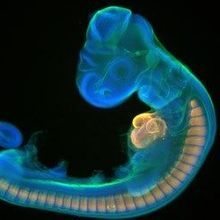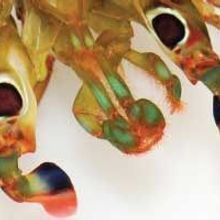Login
Subscribeevolutionary biology

Spiders with Long Tails Found in Ancient Amber
Jim Daley | Feb 5, 2018 | 2 min read
This discovery closes a 170-million-year gap in the fossil record.

Image of the Day: Bacterial Highways
The Scientist and The Scientist Staff | Jan 25, 2018 | 1 min read
Fungal pathways in cheese rinds affect the composition of bacterial communities residing there.

Image of the Day: See You Later!
The Scientist and The Scientist Staff | Jan 8, 2018 | 1 min read
Developmental biologists take a close look at how alligator embryos grow.

Insects’ Neural Learning and Memory Center Discovered in Crustaceans
Catherine Offord | Dec 1, 2017 | 4 min read
Aggressive little marine predators, mantis shrimps possess a mushroom body that appears identical to the one found in insects.

A Newly Identified Species Represents Its Own Eukaryotic Lineage
Katarina Zimmer | Nov 20, 2017 | 2 min read
The 10-micrometer-long flagellate cell might have a big story to tell about the evolution of eukaryotes.

The Weird Growth Strategy of Earth’s First Trees
Shawna Williams | Oct 24, 2017 | 3 min read
Ancient fossils reveal how woodless trees got so big: by continuously ripping apart their xylem and knitting it back together.

Contributors
Aggie Mika | Oct 1, 2017 | 3 min read
Meet some of the people featured in the October 2017 issue of The Scientist.

Do Pathogens Gain Virulence as Hosts Become More Resistant?
Andrew F. Read and Peter J. Kerr | Oct 1, 2017 | 10+ min read
Emerging infections provide clues about how pathogens might evolve when farm animals are protected from infection.

Infographic: Evolving Virulence
Andrew F. Read and Peter J. Kerr | Sep 30, 2017 | 2 min read
Tracking the myxoma virus in the wild rabbit populations of Australia has yielded insight into how pathogens and their hosts evolve.

How Immune Receptors Got into Mouse Noses
Shawna Williams | Sep 1, 2017 | 2 min read
A study traces proteins’ evolution from the immune to the olfactory system.

Pollution Drives Marine Reptile Color Change
Bob Grant | Aug 11, 2017 | 2 min read
The turtle-headed sea snake is losing its stripes, and researchers suggest that the change reflects adaptation to fouled oceans.

Islands North of Antarctica Key to Fish Species Diversity
Shawna Williams | Jul 24, 2017 | 1 min read
Their waters served as refuges during ice ages, allowing for adaptation and the emergence of new species.

Lords of the Flies
Aggie Mika | Jun 19, 2017 | 5 min read
Biologists’ walk in the woods sparks the creation of a masterful fruit fly field guide.

Mammalian Jaws Evolved to Chew Sideways
Catherine Offord | Jun 1, 2017 | 4 min read
Parallel evolution in jaws and teeth helped early mammals diversify their diets.

Study: Fishing Induces Gene Expression Changes
Jef Akst | May 18, 2017 | 2 min read
Harvesting lab-raised zebrafish based on their size led to differences in the activity of more than 4,000 genes, as well as changes in allele frequencies of those genes, in the fish that remained.

Evolution’s Quick Pace Affects Ecosystem Dynamics
Jef Akst | May 1, 2017 | 10+ min read
From fish harvests to cottonwood forests, organisms display evidence that species change can occur on timescales that can influence ecological processes.

Another New Timeline for Homo naledi
Tracy Vence | Apr 27, 2017 | 1 min read
The ancient human may have lived around 200,000 to 300,000 years ago—much more recently than previously estimated.

Study: Diet Contributes to Brain Size
Diana Kwon | Mar 29, 2017 | 2 min read
The results of a historical primate behavior analysis suggest that species with fruit-filled diets evolved larger brains.

In Certain Social Bees, Gut Microbiomes Follow Phylogeny
Ashley P. Taylor | Mar 29, 2017 | 3 min read
Corbiculate bees and their gut-dwelling microbes have been coevolving since the social species evolved from their solitary ancestors around 80 million years ago, scientists suggest.

Dinosaur Phylogenetic Tree Shake-Up
Jef Akst | Mar 24, 2017 | 2 min read
An analysis of 74 dinosaur species leads a group of researchers to reorganize the extinct animals’ evolutionary history.